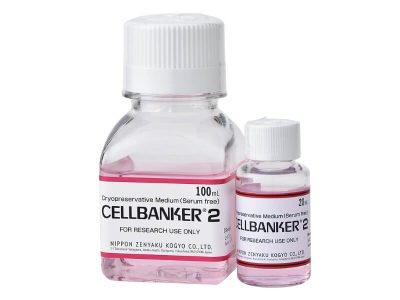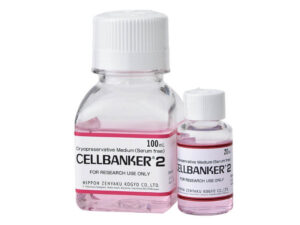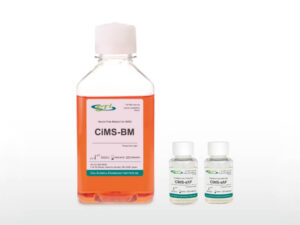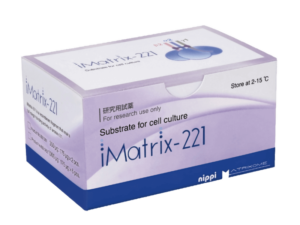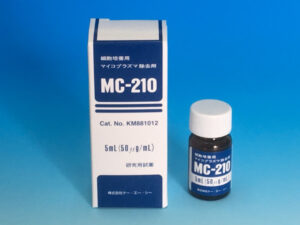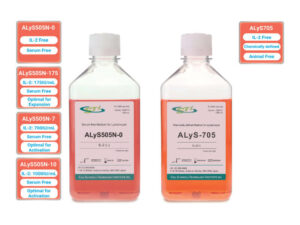CELLBANKER® 2
Preserving standard animal cells, cell lines, tissues, and organoids.
Product Basics
CELLBANKER® 2 is a ready-to-use, serum-free cell cryopreservation medium formulated for a broad spectrum of mammalian cell cultures. The unique formulation enables stable cryopreservation and high viability after the freeze-thaw procedure, without the potential risk of serum contamination.
Key Features
- High cell viability
- Serum-free
- Batch to batch stability
- Ready-to-use
- No programmable freezer required
- Customizable*
*For more information on customization, please click here.
Technical Information
Experimental results
| Cells | Preservation period (Year) | Viability of cells (%) |
|---|---|---|
| Preserved at -80℃ | ||
| MOUSE | ||
| Hybridome | 5 | 90 |
| Myeloma | 5 | 90 |
| L929 | 5 | 90 |
| FM3A | 5 | 90 |
| BALB/3T3 | 5 | 90 | RAT |
| RLC-16 | 5 | 90 |
| NKR | 3 | 90 |
| HAMSTER | ||
| CHO | 3 | 90 |
| V79 | 3 | 90 |
| MONKEY | ||
| COS-1 | 3 | 90 |
| Vero | 5 | 90 |
| HUMAN | ||
| EBV transformed cell | 5 | 90 |
| Fibroblast | 5 | 90 |
| Melanoma | 5 | 90 |
| K562 | 5 | 90 |
| Jurkat | 5 | 90 |
| SK-007 | 5 | 90 |
List of Cells Tested [PDF] – Cell types are constantly being added. Please contact us if you cannot find your cell listed.
Protocol
Freezing
For optimum results, cells for cryopreservation should be in log phase of growth. Similar or other standard freezing protocols may be substituted.
- Examine and make sure the cell culture is free of contamination, in healthy and at proper confluency.
- Perform a cell count to determine the viability of cells.
- Centrifuge at 1,000 – 2,000 rpm, 4°C for 3 to 5 minutes to gently pellet the cells. Remove the supernatant with an aspirator.
- Gently suspend STEM-CELLBANKER® GMP grade cryopreservation medium (1 mL for 5×10⁵ – 5×10⁶ cells).
- Transfer 1 mL of the cell suspension to cryopreservation vial labeled with appropriate information (the cell line name, concentration, passage date etc.).
- Place the vials directly in -80℃ for storage.
- (OPTIONAL) Transfer the frozen vials to a liquid nitrogen storage tank after the vials have been frozen for at least 24 hours.
IMPORTANT: Optimum protocol may change with the cell types.
Thawing
- Remove the cryopreservation vial from the freezer and quickly thaw cells in a 37°C shaking water bath or shake by hand.
- Transfer the content to a centrifugation tube then immediately dilute and gently mix with 10mL of complete cell culture medium. Using CELLOTION® instead of complete culture medium will prevent adhesion of cells to the wall of the tube, increasing the recovery rate.
- Centrifuge cells at 1,000 – 2,000 rpm, 4°C for 3 to 5 minutes. Remove the supernatant with an aspirator.
- Gently resuspend the cells with an appropriate volume of complete cell culture medium then plate in a culture flask or plate
- Continue the culture procedures according to standard protocols.
Specification
- Manufactured By : Zenogen Pharma Co., Ltd
- Size : 100mL (SKU: 11914)
- Storage and Stability : 2 to 8℃ or below -20℃
- Expiration date : 3 years after the date of manufacture
- Disclaimer: For research purposes only
Pricing
CELLBANKER® 2
- Cryopreservation of many of animal cells
- Cryopreservation of common cell lines
- Economical
- Animal component free・Protein free
100ml size
SKU: 11914
Price: $140.00 → $120.00
References & Literature
Ogino, R., Hayashida, K., Yamakawa, S. & Morita, E. Adipose-Derived Stem Cells Promote Intussusceptive Lymphangiogenesis by Restricting Dermal Fibrosis in Irradiated Tissue of Mice. Int J Mol Sci 21, 3885 (2020) doi: 10.3390/ijms21113885.
Yoshimatsu, S. et al. Establishing an induced pluripotent stem cell line from neonatal common marmoset fibroblasts by an all-in-one episomal vector approach. Stem Cell Research 53, 102380 (2021) doi: 10.1016/j.scr.2021.102380.
Hu, Y. et al. Lung cancer organoids analyzed on microwell arrays predict drug responses of patients within a week. Nature Communications 12, 2581 (2021) doi: 10.1038/s41467-021-22676-1.
Wei Yanxing et al. Efficient derivation of human trophoblast stem cells from primed pluripotent stem cells. Science Advances 7, eabf4416 doi: 10.1126/sciadv.abf4416.
Ma, L. et al. CD146 controls the quality of clinical grade mesenchymal stem cells from human dental pulp. Stem Cell Research & Therapy 12, 488 (2021) doi: 10.1186/s13287-021-02559-4.
Bajaj, S. et al. Neurotransmitter signaling regulates distinct phases of multimodal human interneuron migration. The EMBO Journal 40, e108714 (2021) doi: 10.15252/embj.2021108714.
Deng, B. et al. Peripheral leukemia burden at time of apheresis negatively affects the clinical efficacy of CART19 in refractory or relapsed B-ALL. Molecular Therapy – Methods & Clinical Development 23, 633–643 (2021) doi: 10.1016/j.omtm.2021.10.006.
FOR RESEARCH USE ONLY, NOT FOR USE IN DIAGNOSTIC PROCEDURES
